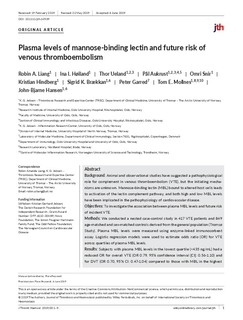| dc.contributor.author | Liang, Robin Amanda | |
| dc.contributor.author | Høiland, Ina Isabella | |
| dc.contributor.author | Ueland, Thor | |
| dc.contributor.author | Aukrust, Pål | |
| dc.contributor.author | Snir, Omri | |
| dc.contributor.author | Hindberg, Kristian | |
| dc.contributor.author | Brækkan, Sigrid Kufaas | |
| dc.contributor.author | Garred, Peter | |
| dc.contributor.author | Mollnes, Tom Eirik | |
| dc.contributor.author | Hansen, John-Bjarne | |
| dc.date.accessioned | 2019-09-16T11:10:27Z | |
| dc.date.available | 2019-09-16T11:10:27Z | |
| dc.date.created | 2019-09-09T14:19:39Z | |
| dc.date.issued | 2019 | |
| dc.identifier.citation | Journal of Thrombosis and Haemostasis. 2019, 1-9. | nb_NO |
| dc.identifier.issn | 1538-7933 | |
| dc.identifier.uri | http://hdl.handle.net/11250/2616971 | |
| dc.description.abstract | Background
Animal and observational studies have suggested a pathophysiological role for complement in venous thromboembolism (VTE), but the initiating mechanisms are unknown. Mannose‐binding lectin (MBL) bound to altered host cells leads to activation of the lectin complement pathway, and both high and low MBL levels have been implicated in the pathophysiology of cardiovascular disease.
Objectives
To investigate the association between plasma MBL levels and future risk of incident VTE.
Methods
We conducted a nested case‐control study in 417 VTE patients and 849 age‐matched and sex‐matched controls derived from the general population (Tromsø Study). Plasma MBL levels were measured using enzyme‐linked immunosorbent assay. Logistic regression models were used to estimate odds ratio (OR) for VTE across quartiles of plasma MBL levels.
Results
Subjects with plasma MBL levels in the lowest quartile (<435 ng/mL) had a reduced OR for overall VTE (OR 0.79, 95% confidence interval [CI]: 0.56‐1.10) and for DVT (OR 0.70, 95% CI: 0.47‐1.04) compared to those with MBL in the highest quartile (≥2423 ng/mL) after multivariable adjustments. For VTE, DVT, and pulmonary embolism (PE) the ORs decreased substantially with decreasing time between blood sampling and VTE event.
Conclusions
Our findings suggest that low plasma MBL levels are associated with reduced risk of VTE, and DVT in particular. | nb_NO |
| dc.language.iso | eng | nb_NO |
| dc.publisher | Wiley | nb_NO |
| dc.rights | Navngivelse-Ikkekommersiell 4.0 Internasjonal | * |
| dc.rights.uri | http://creativecommons.org/licenses/by-nc/4.0/deed.no | * |
| dc.title | Plasma levels of mannose-binding lectin and future risk of venous thromboembolism | nb_NO |
| dc.type | Journal article | nb_NO |
| dc.type | Peer reviewed | nb_NO |
| dc.description.version | publishedVersion | nb_NO |
| dc.source.pagenumber | 1-9 | nb_NO |
| dc.source.journal | Journal of Thrombosis and Haemostasis | nb_NO |
| dc.identifier.doi | 10.1111/jth.14539 | |
| dc.identifier.cristin | 1722878 | |
| dc.description.localcode | This is an open access article under the terms of the Creative Commons Attribution-NonCommercial License, which permits use, distribution and reproduction in any medium, provided the original work is properly cited and is not used for commercial purposes. © 2019 The Authors | nb_NO |
| cristin.unitcode | 194,65,15,0 | |
| cristin.unitname | Institutt for klinisk og molekylær medisin | |
| cristin.ispublished | true | |
| cristin.fulltext | original | |
| cristin.qualitycode | 1 | |

